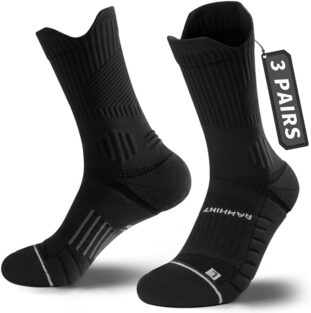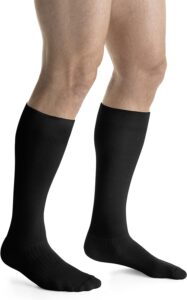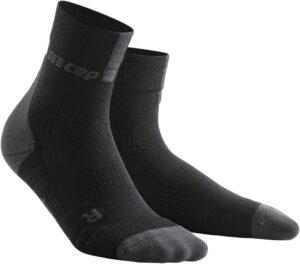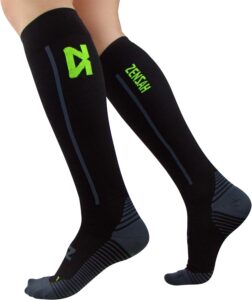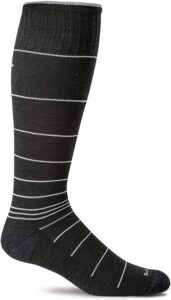Black colored mens compression socks are very popular but with so many brands out there, which one should you buy? Once again, due diligence is required so you do not end up picking up a pair that does not adequately suit your needs.
While this article briefly reviews the benefits, types, length options, and fit, it also explores some black colored compression socks for men from reputable brands.
Importance of Selecting the Right Compression Socks for Men
Choosing the appropriate compression socks for men is necessary for several reasons. First and foremost, the right pair can significantly impact your overall well-being and comfort.
Wearing ill-fitting or improper compression socks can lead to discomfort, reduced effectiveness, or even potential health risks.
Moreover, selecting the right socks tailored to your specific needs and lifestyle can maximize the benefits they offer.
7 Reasons Why Black Mens Compression Socks are Popular
These socks have gained popularity because they offer a combination of versatility, professionalism, discreetness, health benefits, and fashion appeal.
The color black complements various styles and occasions while providing the benefits of compression therapy to the legs.
Health Benefits: Compression socks are often worn for health reasons, such as improving blood circulation, reducing swelling, and preventing deep vein thrombosis (DVT).
Men, like women, may wear black options of these socks for health benefits, regardless of fashion considerations.
Versatility: Black is a neutral and versatile color that goes well with most clothing choices, making black socks suitable for both formal and casual occasions.
For some men, black compression socks may also be a fashion statement. They can be worn with dress shoes, sneakers, or boots without clashing with the overall look.
Professional Appearance: Many professionals, such as healthcare workers, pilots, and office workers, wear black options of these socks to combat the effects of long hours of standing or sitting.
Black compression socks provide a professional and inconspicuous appearance that fits well with uniforms or business attire.
Reduced Visibility of Stains: Black socks are less likely to show dirt or stains compared to lighter-colored options, making them a practical choice for individuals who want to maintain a clean appearance throughout the day.
Discreetness: Some individuals may feel self-conscious about wearing compression socks, especially if they are relatively young and active.
Black socks are less noticeable than brightly colored ones, allowing wearers to maintain a more discreet appearance.
Unisex Appeal: Black is a color that appeals to both men and women, making black compression socks a popular choice for a broad range of individuals.
Athletic Use: Athletes and active individuals use compression socks for performance and recovery benefits. Black colored socks can be paired with various athletic outfits, making them suitable for workouts, sports, and post-exercise recovery.
Benefits of Compression Socks
Improved Blood Circulation
Compression socks are primarily designed to enhance blood circulation in the legs. The graduated pressure they exert helps to push blood back up towards the heart, counteracting the force of gravity.
This prevents blood from pooling in the lower extremities and reduces the risk of conditions like varicose veins and edema (swelling). Improved circulation also means better oxygen and nutrient delivery to the muscles, promoting overall leg health.
Prevention of Deep Vein Thrombosis
DVT occurs when a blood clot forms in a deep vein, typically in the legs. Compression socks help promote blood flow, reducing the risk of clot formation.
They are often recommended for individuals at higher risk of DVT, such as those on long flights or recovering from surgery.
Reduced Muscle Fatigue
Wearing compression socks can significantly reduce muscle fatigue, making them popular among athletes and individuals with physically demanding jobs.
The increased blood flow and support to the leg muscles help minimize muscle vibration and micro-tears, which occur during prolonged activity.
As a result, you experience less muscle soreness and fatigue, allowing you to perform better and recover more quickly.
Enhanced Athletic Performance
Athletes use compression socks to improve their performance during both training and competition.
By reducing muscle vibration and optimizing oxygen delivery to muscles, these socks can enhance endurance and overall athletic performance. Additionally, they aid in post-exercise recovery by reducing muscle soreness and swelling.
Types of Socks – Compression Brands
When selecting these socks, you must consider various factors to ensure you choose the right pair that meets your specific needs and preferences. Do not just settle for any because you could be causing yourself harm. Here are some key aspects to understand:
Graduated or Uniform Compression
Graduated compression socks are the most common choice for medical and sports purposes, and are designed with varying levels of pressure throughout the length of the sock, being tightest at the ankle and gradually decreasing in pressure as they move up the leg.
This design promotes efficient blood flow, helping to prevent swelling and improve circulation.
Uniform compression type of socks are often used for fashion purposes or milder support needs. They apply the same amount of pressure uniformly across the entire length of the sock.
While they can provide some benefit, they are generally less effective than their graduated counterparts in promoting blood circulation and preventing certain medical conditions.
Length Options of Mens Black Compression Socks
Knee-High: This type of compression socks typically covers the lower leg up to just below the knee. They are a popular choice for everyday wear and are often recommended for individuals who want to address mild leg discomfort or swelling.
Thigh-High: These black compression type socks extend up to the thigh area. They provide compression to both the calf and thigh muscles, making them suitable for conditions that affect a larger portion of the leg or for individuals recovering from surgery.
Full-Length: Full-length compression type stockings cover the entire leg, providing full support from the foot to the top of the thigh. These are commonly used in medical settings, especially for patients with severe venous insufficiency or lymphedema.
Compression Levels
Compression socks come in various pressure levels – Mild, Moderate, High each serving different purposes:
Mild Compression (8-15 mmHg): Socks with mild compression are often used for preventive purposes. They help alleviate minor leg discomfort, reduce the risk of swelling during long periods of sitting or standing, and are suitable for travel.
Moderate Compression (15-20 mmHg to 20-30 mmHg): Socks with moderate compression are recommended for managing various conditions like varicose veins, spider veins, and mild edema.
They are also popular among athletes for performance and recovery.
High Compression (30-40 mmHg and above): Socks with high compression are typically prescribed by healthcare professionals to manage more severe conditions like deep vein thrombosis (DVT), severe venous insufficiency, or lymphedema.
These socks exert significant pressure to promote blood circulation and reduce swelling.
Material Options
The choice of materials used to make compression socks for men can impact their comfort and effectiveness
When selecting the material, consider your personal preferences, any allergies or sensitivities, and the intended use of the socks to ensure the best combination of comfort and effectiveness.
Nylon: Nylon is a common material used in these compression crafted socks because of its durability and elasticity. It provides a snug fit and maintains its shape over time.
Spandex: Spandex is often blended with other materials to provide stretch and flexibility. It allows for a comfortable fit while maintaining the necessary compression.
Cotton Blends: Some socks incorporate cotton for breathability and moisture-wicking properties. These blends can be a good choice for individuals with sensitive skin or those who prefer natural fibers.
Microfiber Blends: Microfiber blends offer a soft and comfortable feel against the skin. They are known for moisture management, making them suitable for all-day wear.
Sizing and Fit
Choosing the correct size for your socks is paramount to ensure they provide the intended benefits and comfort.
Poorly-fitting compression socks can lead to discomfort, inadequate support, or even exacerbate underlying issues. These are the reasons why proper sizing matters:
Effectiveness: Compression socks exert pressure on the legs to improve circulation and reduce swelling. If they are too tight or too loose, they will not apply the appropriate pressure, diminishing their therapeutic effects.
Comfort: Wearing the wrong size can be uncomfortable, causing chafing, bunching, or excessive pressure in certain areas. Properly sized compression socks should feel snug but not overly restrictive.
Prevention of Complications: An incorrect fit can potentially lead to skin irritation, blisters, or circulation problems. In some cases, it can even worsen existing conditions, such as varicose veins or edema.
How to Measure for the Right Fit
To determine the correct size for your socks, follow these steps:
Ankle Circumference: Measure the circumference of your ankle at its narrowest point, just above the ankle bone. Use a flexible tape measure or a piece of string, then measure the string against a ruler.
Calf Circumference: Measure the widest part of your calf. For knee-high or thigh-high socks, take this measurement at the widest point below the knee.
Calf Length: Measure from the floor to the crease behind your knee. This measurement is essential for ensuring that knee-high or thigh-high socks fit properly without bunching.
Thigh Circumference (if applicable): If you are considering thigh-high or full-length compression socks, measure the circumference of your thigh at its widest point.
Shoe Size: Know your shoe size, as some sock brands use this as an additional sizing reference.
Once you have taken these measurements, consult the sizing chart provided by the manufacturer or retailer of the compression socks you are interested in.
Sizing charts typically match your measurements with the appropriate sock size. Keep in mind that different brands may have slightly different sizing guidelines, so it is essential to follow the specific chart for the brand you are purchasing.
Ensure that both the sock size and compression level align with your measurements and healthcare recommendations. A well-fitted sock in the appropriate compression level will offer the best balance between comfort and therapeutic effectiveness.
If you are unsure about sizing or the right compression level for your needs, consult with a healthcare professional or a knowledgeable sales representative for guidance
Style and Design Preferences
Color Options
Neutral Colors: For a versatile and discreet look, opt for neutral colors like black, beige, or navy. These colors blend well with most outfits and are ideal for professional or formal settings.
Bright Colors: If you want to add a pop of color to your wardrobe, many compression sock brands offer a range of vibrant hues. This can be a fun way to express your style while still benefiting from the compression support.
Patterns and Aesthetics
Give thought to your personal style preferences and comfort needs when choosing the aesthetics and features of your compression socks.
Finding a balance between functionality and fashion will ensure that you not only experience the therapeutic benefits but also feel confident and comfortable in your socks.
Solid Colors: Solid-colored compression socks provide a classic and timeless appearance that work well in in almost various situations.
Patterns: If you prefer a more fashionable look, consider compression socks with patterns such as stripes, polka dots, or geometric designs. These can add a touch of personality to your outfit.
Medical Aesthetics: Some compression socks are designed to look like traditional medical stockings, with a beige or sheer appearance. These options are discreet and suitable for formal occasions.
Sock Features
Toe Seams: Look for socks with smooth, flat toe seams or seamless designs. This prevents irritation and discomfort around the toes, especially during extended wear.
Cushioning: Some compression type socks include extra cushioning in the heel and sole areas for added comfort. This can be beneficial if you are on your feet for extended periods.
Non-Binding Tops: Socks with non-binding, wide tops help prevent constriction around the calf and reduce the risk of sock-induced pressure points.
Popular Brands in the Market
When selecting compression socks, it is essential to be aware of popular and reputable brands known for their quality and effectiveness. Here are some well-regarded brands in the compression sock market:
Sigvaris
Sigvaris is a trusted name in medical compression garments, offering a wide range of compression levels and styles, from medical-grade to fashion-forward designs.
Jobst
Jobst is another established brand known for its medical-grade compression stockings. They provide options for various medical conditions, including venous insufficiency and lymphedema.
CEP
CEP specializes in compression sportswear, catering to athletes looking for performance-enhancing compression socks. They offer a range of styles and compression levels designed for different sports.
Sockwell
Sockwell combines style and comfort with graduated compression. Their socks are designed for everyday wear and come in a variety of fashionable patterns and colors.
Zensah
Zensah is renowned for its compression sleeves and socks designed for athletes. Their products often feature moisture-wicking technology and targeted compression zones.
Rehband
Rehband offers compression sleeves and socks, with a focus on durability and support for athletic performance and recovery.
Pricing
When considering pricing, always balance your budget with your specific needs and preferences.
While it can be tempting to choose the most affordable option, investing in high-quality compression socks from reputable brands may provide better comfort and durability in the long run.
The price of compression type socks can vary widely depending on compression level, brand, customization, material and features, and quantity to be bought.
Generally, higher compression levels (e.g., medical-grade) tend to be more expensive than lower levels used for prevention or athletic performance, while well-established brands with a reputation for quality similarly command higher prices.
Custom-made compression socks, tailored to your measurements, are typically more expensive than off-the-shelf options, and socks made from specialized materials or featuring extra cushioning may also come at a higher price point.
However, buying these socks in multipacks or bundles can offer cost savings compared to purchasing individual pairs.
Related Articles
- What is the #1 Best treatment for Leg Cramps? Shocker
- Poor Circulation Problems in Seniors – The Real Dangers
- The Best Products That Can Help Improve Poor Blood Circulation
- Compression Leg Socks – How to Select and Buy
- Compression Socks For Men or Women – Better than Unisex?
- The Best Copper Infused Compression Socks
- Copper Fit Compression Socks for Men – What to Look For
- Foot Problems and Diabetes. Why Important for Seniors?
- The Causes of Poor Blood Circulation in Aging Adults
Conclusion – Best Black Mens Compression Socks
Use this guide to help you select compression socks for the next next time you want to buy them. Note that the lifespan of these socks varies depending on factors like wear frequency, care, and the quality of the brand.
Higher quality brands may last anywhere from 6 months to 1 year or more and are worth the investment in the long run than the considerably cheaper alternatives. Try them out today!
References
Howley, E.K (2023) The Most Common Signs of Poor Circulation and How to Improve Them https://health.usnews.com/wellness/articles/how-to-improve-poor-circulation

